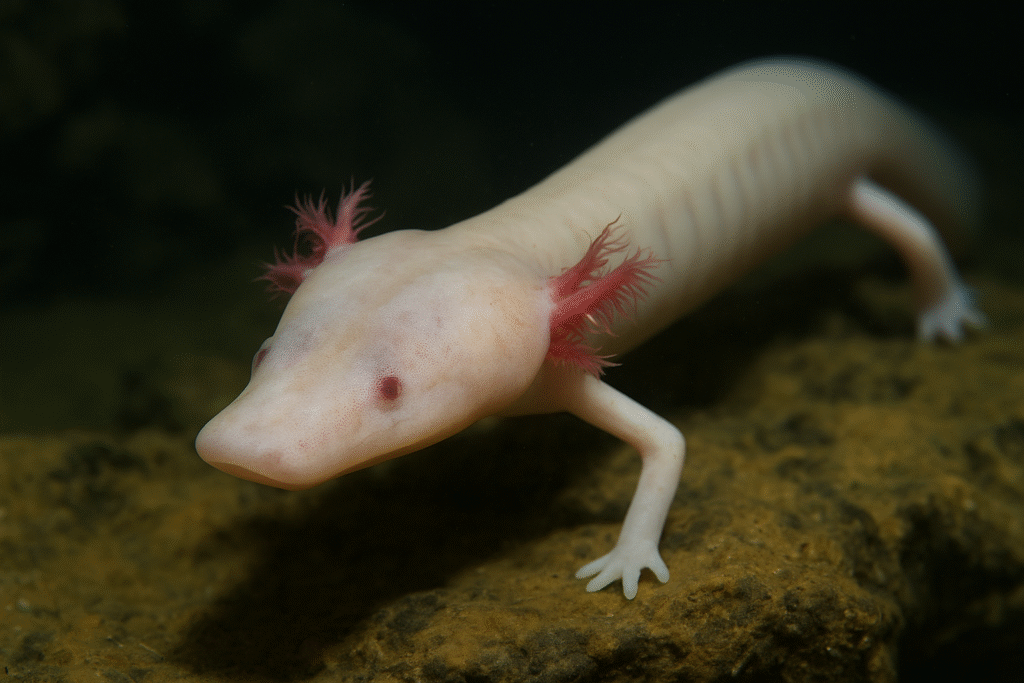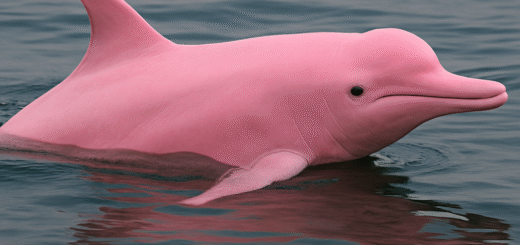The Olm: A Mysterious and Fascinating Cave Dweller
The Olm (Proteus anguinus), also known as the “human fish”, is a unique and mysterious amphibian found in the submerged caves of the Dinaric Alps in Europe, particularly in Slovenia, Croatia, and parts of Italy. With its otherworldly appearance and extraordinary adaptations, the Olm has long captivated researchers, biologists, and curious minds alike.

A Peek into the Olm’s Biology
The Olm is a type of salamander, but it possesses a range of characteristics that set it apart from its more familiar relatives. Typically measuring between 20 and 30 centimeters (7.9 to 11.8 inches) in length, this blind amphibian has a serpentine body, smooth skin, and delicate external gills that extend from the sides of its head. These gills, which are pinkish-red and appear almost feathery, are crucial for its survival in the oxygen-deprived underwater cave environment.
What’s most remarkable about the Olm is its complete lack of eyesight. Over millions of years of living in dark caves, this species has evolved to completely lose its vision. Instead, it relies on an extraordinary sense of chemoreception (chemical sensing) to navigate and find food. Its keen sense of smell allows it to detect prey such as insects, crustaceans, and small fish in the murky waters of the caves.
Habitat and Distribution
The Olm’s habitat is limited to the submerged karst caves of the Dinaric Alps, an area of limestone rock formations that provide the unique aquatic environments where the species thrives. These caves are often dark, cold, and isolated, with minimal light penetration. The Olm is well-adapted to this environment, with its ability to survive in complete darkness and its slow metabolism that helps it endure the cave’s food scarcity.
Due to its restricted range, the Olm is considered an endemic species to the area. The caves it inhabits have made the Olm a subject of fascination in the study of cave ecosystems and evolutionary biology.
Adaptations to Cave Life
The Olm’s adaptations are nothing short of remarkable. Here are some key features that make the species unique:
- Loss of Vision: The Olm’s eyes, while present, are underdeveloped and covered by skin. This evolutionary trait is a result of living in complete darkness for thousands of years. The lack of light in its cave environment rendered vision unnecessary, so the Olm’s eyes slowly degenerated.
- External Gills: Unlike most amphibians, which typically have internal gills that disappear as they mature, the Olm retains its external gills throughout its entire life. These gills are necessary for respiration in the low-oxygen waters of the cave.
- Slow Metabolism: Olms have a very slow metabolism, which allows them to survive long periods without food. They can go without eating for months at a time, a vital adaptation in an environment where food is scarce.
- Longevity: The Olm is known for its remarkable lifespan, often living up to 100 years in the wild. This longevity is another adaptation to its environment, where resources are limited, and survival is challenging.
Reproductive Mysteries
The Olm’s reproduction is shrouded in mystery. These creatures are slow breeders, and much about their mating behavior is still not fully understood. Females can live for decades, and it is believed that they may not reproduce until they are at least 10 years old. Reproduction occurs in the water, where males release sperm, and fertilization happens internally.
Because Olms are so elusive, researchers have had limited opportunities to study their breeding habits in the wild. However, it is known that their populations are relatively low, making them vulnerable to threats such as habitat destruction and climate change.
Conservation Status
The Olm is currently listed as a vulnerable species due to its limited range and the fragility of its cave ecosystem. The primary threats to its survival include habitat degradation, pollution, and human encroachment into its natural caves. Even though the species is protected by law in many countries, their habitat is increasingly at risk due to tourism and infrastructure projects in the region.
The Olm’s habitat is also sensitive to climate change, particularly changes in water temperature and chemical composition, which could negatively affect the delicate balance of its cave ecosystem. Conservation efforts are critical to ensure that the Olm continues to thrive in the caves of the Dinaric Alps.
The Olm in Popular Culture
Over the years, the Olm has become somewhat of a legend in the local folklore of the countries where it resides. Its eerie appearance and rare status have given it an almost mythical reputation, often referred to as a “dragon” or “mermaid” in various tales. Its scientific name, Proteus anguinus, references the ancient Greek sea god Proteus, who could change form, symbolizing the Olm’s mysterious and elusive nature.
In modern times, the Olm has captured the imagination of the public, becoming a subject of documentaries, books, and exhibitions. Its fascinating biology and adaptations to a dark, isolated environment have made it a symbol of evolution’s ability to craft unique solutions to the challenges of life on Earth.
Conclusion
The Olm is truly one of nature’s most enigmatic and captivating creatures. With its blind, serpentine body, feather-like gills, and remarkable adaptations to life in total darkness, it is a living testament to the wonders of evolution and the resilience of life in even the harshest environments. As scientists continue to study the Olm, there is still much to learn about this mysterious cave dweller, its ecosystem, and its survival in an increasingly fragile world.
For those interested in the Olm’s ongoing conservation and efforts to protect its habitat, supporting local conservation programs and promoting sustainable tourism can make a significant difference in ensuring the survival of this remarkable creature.








